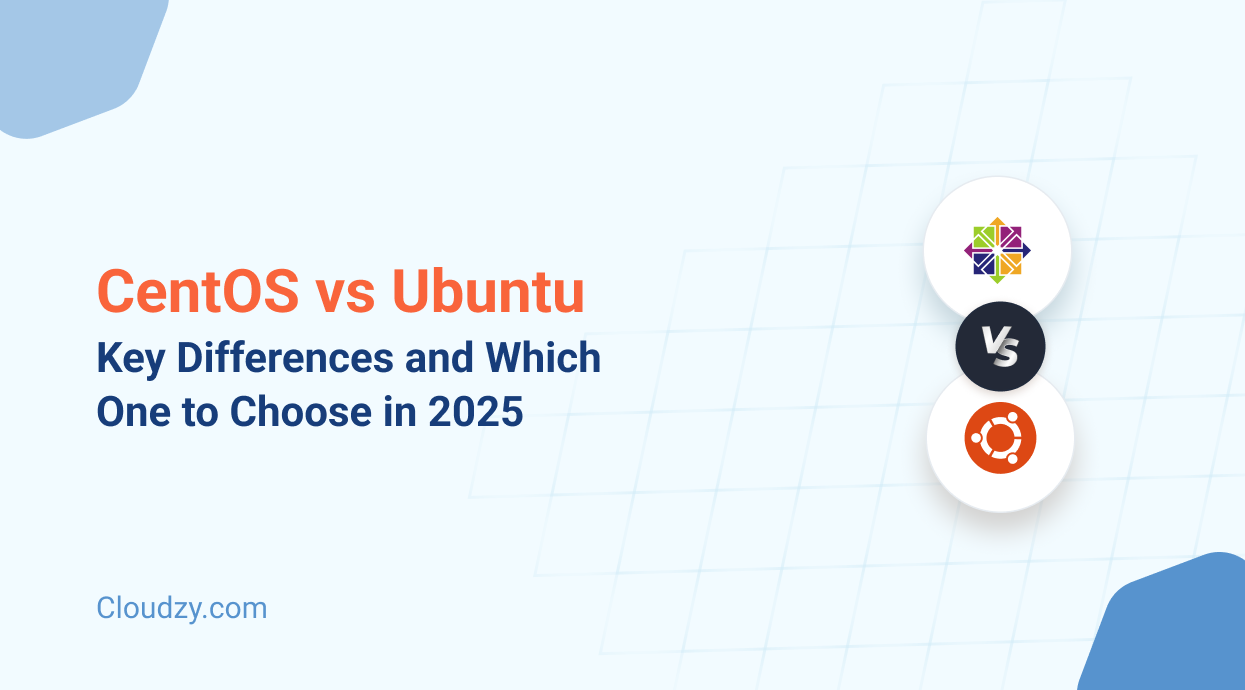CentOS isn’t what it used to be. The reliable, rock-solid CentOS Linux is gone, replaced entirely by CentOS Stream. This shift fundamentally changes its role in the server world.
Now acting as an upstream development branch for Red Hat Enterprise Linux (RHEL), CentOS Stream gets updates before RHEL, making it a rolling-release distribution. While useful for developers testing upcoming changes, it’s less predictable—hardly ideal for production environments that demand long-term stability.
For organizations needing a stable, RHEL-compatible OS, alternatives like AlmaLinux and Rocky Linux step in, maintaining binary compatibility with RHEL and filling the gap left by CentOS Linux.
This change also redefines how CentOS and Ubuntu compare in 2025. If stability is your priority, CentOS Stream isn’t the answer. Ubuntu LTS or an RHEL-based alternative is the smarter choice for production-ready deployments.
Key Differences Between CentOS and Ubuntu
Although both CentOS and Ubuntu are widely used in server environments, they have fundamental differences in architecture, update cycles, package management, and overall use cases. These differences directly impact long-term stability, security, and software availability.
System Base and Architecture
CentOS was built on Red Hat Enterprise Linux, using RPM packages managed by YUM/DNF. This made it compatible with enterprise software designed for RHEL environments.
Ubuntu is based on Debian and uses DEB packages managed through APT. This package management system is widely supported and often more accessible for users unfamiliar with enterprise-focused distributions.
For those used to CentOS Linux, switching to Ubuntu requires adapting to a different package management system. Users who need a familiar RHEL-like environment may find AlmaLinux or Rocky Linux to be better choices.
Release Cycle and Stability
CentOS Linux was historically known for stability, as it followed RHEL’s update cycle. However, CentOS Stream does not function the same way. Instead of receiving updates after they have been tested in RHEL, it now gets them before RHEL does, making it a rolling-release system.
Ubuntu, by contrast, has predictable update cycles. LTS versions are released every two years and receive five years of security updates, making them suitable for long-term production use.
For anyone who needs stability over constant updates, Ubuntu LTS is a more reliable option than CentOS Stream
Performance and Resource Usage
CentOS Linux was optimized for enterprise workloads, with a minimalist approach that reduced unnecessary software overhead. Linux’s dominance in web hosting is evident, with 96.3% of the top one million web servers running on Linux. Ubuntu, while efficient, includes more built-in features by default, making it slightly heavier on system resources.
For VPS hosting and cloud computing, Ubuntu has become a more common choice due to its strong integration with AWS, Google Cloud, and Microsoft Azure. Many cloud providers offer Ubuntu as the default OS due to its widespread support and frequent updates.
CentOS, in contrast, was traditionally used in enterprise data centers where long-term stability was the top priority. Since CentOS Stream does not meet that standard anymore, users needing a low-maintenance, stable OS may prefer Ubuntu LTS or an RHEL-based alternative.
CentOS Stream updates frequently, which can introduce performance shifts. These changes help developers access new features sooner, but administrators may need to monitor updates more closely to avoid unexpected behavior.
Ubuntu takes a more structured approach, especially with its Long-Term Support (LTS) versions. These releases get updates on a fixed schedule, keeping performance more predictable over time.
Security Features and Updates
Both CentOS and Ubuntu use security frameworks to control system access. CentOS relies on SELinux (Security-Enhanced Linux), while Ubuntu uses AppArmor.
SELinux enforces strict policies at a granular level but requires careful configuration. Many administrators disable it due to its complexity. AppArmor, in contrast, is easier to set up but does not provide the same level of control.
Security updates also work differently. Ubuntu LTS follows a structured update cycle, with frequent, well-documented patches. CentOS Stream receives updates regularly, but these are not always fully tested before release.
For those needing predictable security updates, Ubuntu LTS is the safer choice. Organizations looking for RHEL compatibility without CentOS Stream’s unpredictability can use AlmaLinux or Rocky Linux, which follow the same security standards as traditional CentOS Linux.
Community Support and Documentation
Ubuntu has a large community and extensive documentation, making it one of the most accessible Linux distributions for both beginners and experienced administrators. Canonical also offers official support for enterprises that require professional assistance.
CentOS was once widely supported by its enterprise user base, but the shift to CentOS Stream has led to fragmentation. Many users have moved to AlmaLinux or Rocky Linux, splitting the CentOS support network.
For users who need strong community support and extensive documentation, Ubuntu remains the better choice.
 The Ultimate Minimal Server
The Ultimate Minimal Server
Get CentOS 7 or CentOS 8 on your Cloudzy CentOS VPS and run an efficient Linux-based server with minimal resource consumption.
Get a CentOS VPSAdvantages of CentOS
Before its discontinuation, CentOS was widely used in enterprise environments and hosting. Its biggest strength was stability. Built from Red Hat Enterprise Linux (RHEL), it followed the same release model, ensuring a well-tested, consistent system.
CentOS was also binary-compatible with RHEL, allowing businesses to run Red Hat software without modifications. This made deployment easier, particularly for companies relying on RHEL-based applications.
It came with SELinux enabled by default, providing a strong security framework for managing permissions. While it required detailed configuration, it gave enterprises more control over system security.
Finally, CentOS was free, making it a practical alternative to RHEL for organizations that didn’t require official support.
Disadvantages of CentOS
CentOS continues to be utilized by 22% of organizations, with the technology sector showing an even higher usage rate of 28%. However, despite its strengths, CentOS had its downsides. One of the biggest issues was software availability. Compared to Ubuntu, CentOS had a smaller software repository. Many applications had to be installed through third-party repositories, such as EPEL, instead of being readily available.
Another challenge was limited commercial support. Unlike Ubuntu, which has official support through Canonical, CentOS relied entirely on community assistance. Businesses needing professional support had to switch to RHEL or pay for third-party services.
CentOS also had a slow update cycle, which was both a benefit and a drawback. While this ensured stability, it meant that software versions became outdated over time unless updated manually.
With CentOS Linux discontinued, these drawbacks are even more relevant. CentOS Stream does not provide the same stability, and the benefits that made CentOS Linux reliable have largely shifted to AlmaLinux and Rocky Linux.
In addition to AlmaLinux and Rocky Linux, Debian is another alternative that works well for users looking for stability. It follows a cautious release cycle, prioritizing reliability. This makes it a strong option for enterprise environments where system consistency is more important than frequent updates. It also has a large software repository, reducing the need for third-party sources.
Advantages of Ubuntu
Ubuntu remains a strong choice for server environments because of several factors. One of its biggest strengths is ease of use. Compared to CentOS, Ubuntu is simpler to set up, which makes it an ideal choice for new users and developers. It also provides better built-in support for modern software, reducing the need for third-party repositories. Its compatibility with advanced virtualization techniques, such as nested virtualization, allows users to run virtual machines within virtual machines, enhancing testing and development environments.
Another advantage is its structured release cycle. The LTS (Long-Term Support) versions receive five years of updates, making Ubuntu a predictable choice for production servers. This level of stability allows businesses to plan ahead without worrying about unexpected system changes.
For those working in cloud computing, Ubuntu has a strong presence. It is the most commonly used Linux distribution on AWS, Google Cloud, and Microsoft Azure. Its compatibility with containerization technologies, such as Docker and Kubernetes, makes it well-suited for modern application deployments.
Ubuntu also has a large community and commercial support options. Ubuntu’s widespread adoption is reflected in its 2.19% share of the server and desktop OS market. Canonical provides enterprise-grade support for organizations that need direct assistance, something that CentOS Linux never offered.
Disadvantages of Ubuntu
Ubuntu has some downsides that are worth considering. One of them is frequent updates. While LTS versions are stable, users running non-LTS versions must upgrade their systems every six months.
Another drawback is that Ubuntu’s default configurations focus on accessibility, which may not be the best fit for enterprise environments that require more customized security policies. Ubuntu on the other hand does not come with SELinux enabled by default, which means administrators must configure additional security settings manually.
For those used to RPM-based package management, switching to APT and DEB packages requires adjustments in workflow. While Ubuntu’s package management system is widely supported, it differs from CentOS and RHEL, which could make migrations more complex.
CentOS vs Ubuntu Server: Which One Suits Your Needs?
For years, the CentOS vs Ubuntu server debate revolved around stability versus flexibility. CentOS Linux was chosen for long-term reliability, while Ubuntu was preferred for its ease of use and frequent updates. Now that CentOS Linux is discontinued, the question is whether CentOS Stream is a viable alternative or if users should migrate to Ubuntu.
For those looking for a direct CentOS replacement, AlmaLinux and Rocky Linux provide an experience closer to the original CentOS Linux than CentOS Stream does. These distributions follow a more predictable update cycle. However, for users focused on cloud environments, software compatibility, and easier maintenance, Ubuntu LTS is the better choice.
CentOS vs Ubuntu for VPS Hosting: Cloudzy’s Solution
Choosing the right VPS hosting provider is just as important as selecting an operating system. A strong infrastructure ensures stability, security, and performance, whether you’re running a CentOS replacement or setting up an Ubuntu server.
At Cloudzy, we provide Linux VPS hosting that supports Ubuntu LTS and RHEL-based alternatives, including AlmaLinux. Our VPS comes with NVMe SSD storage, DDR4 RAM, and a global network of 15+ data centers to deliver low-latency performance and 99.95% uptime. This makes Cloudzy a great choice for developers, businesses, and IT professionals who need a secure, high-speed VPS.
For those moving away from CentOS Linux or setting up a new Ubuntu server, Cloudzy provides full root access, allowing users to customize their hosting environment according to their needs. Whether it’s hosting applications, running a VPN, or managing development projects, Cloudzy’s Linux VPS offers the stability and control required for smooth operation.
With the ability to run Ubuntu, AlmaLinux, and other Linux distributions, Cloudzy provides a VPS solution that works for both enterprise and individual users.
 The Obvious Choice
The Obvious Choice
The majority of Linux-run servers are using Ubuntu; why not you? Discover why everybody loves Ubuntu — get an optimized Ubuntu VPS
Get your Ubuntu VPSConclusion
The difference between CentOS and Ubuntu is more noticeable now than ever before. CentOS Linux is gone, and CentOS Stream is not a direct replacement. Ubuntu, with its LTS versions and long-term support, remains a stable choice for production servers.
For users who need an RHEL-compatible alternative, AlmaLinux or Rocky Linux are the best options. However, for those looking for cloud support, better documentation, and simpler package management, Ubuntu LTS is the best option.
FAQs
What happened to CentOS Linux?
CentOS Linux was discontinued by Red Hat and replaced with CentOS Stream, which does not provide the same level of stability.
What is the main difference between CentOS and Ubuntu?
CentOS was based on RHEL and used RPM packages, while Ubuntu is based on Debian and uses DEB packages. Ubuntu offers official support through Canonical, while CentOS relied on community support.
Is CentOS Stream a good alternative to CentOS Linux?
Not for production environments. Since CentOS Stream receives updates before RHEL, it is less stable than CentOS Linux. Users who need a predictable release cycle should consider AlmaLinux, Rocky Linux, or Ubuntu LTS.
Which is better for VPS hosting?
Ubuntu LTS is the best choice due to its reliable update cycle, cloud compatibility, and extensive software repository.
Can I still use CentOS?
Only CentOS Stream, but it is not the same as CentOS Linux. For a stable alternative, consider AlmaLinux, Rocky Linux, or Ubuntu LTS.




9 Responses
Incredible, thanks for this great information.
Amazing post, many thanks for this valuable content.
Which one do web admins prefer for web hosting?
Amazing comparison between ubuntu and centos! I have been an ubuntu user since a couple of years ago but now I am motivated to give centos a try
I think centos would be a better solution for those who want to host their site
For business activities i would definitely not suggest ubuntu, based on what you need you may need to consider some other distros
Features CentOS Ubuntu
Update Cycle As required Regularly
System Core Based on Red Hat Linux Based on Debian
Package Management APT YUM
Features CentOS Ubuntu
Package Management APT YUM
This is incorrect. CentOS uses YUM, Ubuntu uses APT
Features CentOS Ubuntu
Package Management APT YUM
This is incorrect. CentOS uses YUM, Ubuntu uses APT